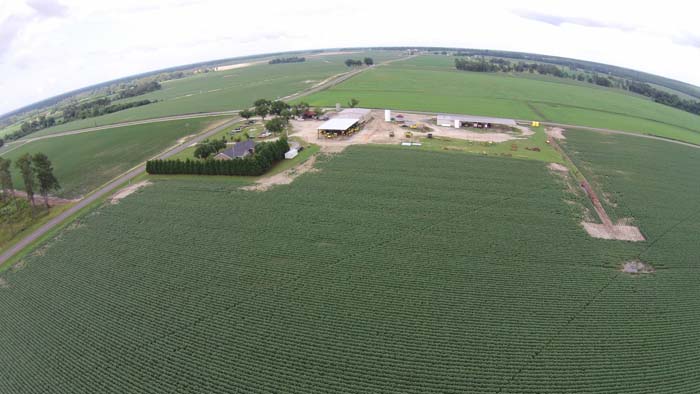Farmers long for a bird’s-eye view of their crops
Published 7:13 am Saturday, September 19, 2015

- A Dooly County farm as seen from a drone camera.
When one of Stan Savage’s 130 cows looks for solitude on his 320-acre farm in Moultrie, she can be tough to find.
“You have to drive the entire pasture sometimes to find that one cow that’s gotten away from the herd because she’s going to have her calf over in the far corner under a bush,” Savage said.
When he thinks of the time and fuel devoted to these searches, the appeal of a drone increases. A bird’s-eye view of his property, he says, would make a wayward cow easier to spot. He could also more easily count his cattle.
Keeping tabs on cows just may be the start for the agricultural community, which is expected to become a major user of the pilotless aircraft.
Drones’ full potential won’t be seen, though, until the Federal Aviation Administration finalizes rules on their commercial use, said Chip Blalock, executive director of the Sunbelt Ag Expo in Moultrie, which added a drone demonstration to its lineup last year.
“We’re kind of waiting on all that to settle out,” he said.
Individual farmers like Savage can use the technology on their property now, but the federal government is still determining how to regulate those who want to deploy drones as part of a business.
That complicates things in the agriculture industry which expects crop consultants – not farmers themselves – to be primary users of the more sophisticated aircraft.
With the right cameras and software, drones can identify problems with a crop quickly, then direct a specific amount of pesticides and fertilizers to apply without overdoing it.
Right now much of that work, called scouting, is done on foot.
Savage imagines the benefit using a $1,500 drone to patrol his hayfield for pests, particularly masses of eggs laid by the destructive armyworm.
But most of the advanced monitoring, Blalock said, will likely fall to specialists whose souped-up machines offer a level of analysis not currently available to farmers.
For now, the federal government doesn’t allow those business to use drones without an exemption, although it has given more than 1,500 exemptions as it finalizes its rules. Those regulations on commercial drone use are expected to be published next year.
As proposed, the regulations won’t exactly throw open the doors for those who want to survey fields with advanced cameras.
Industry groups, including the National Association of Wheat Growers, have criticized limits being discussed on how high and far the drones can fly.
As it is, drones would have to stay within an operator’s line of sight. Industry groups say that will mean time wasted to relocate a drone when scanning a large field.
Those groups also say a proposed 500-foot ceiling for drones is needless in rural areas without crowded airspace. The limit is significant because the higher a drone flies, the more land its camera can survey.
As the federal government protects airspace, state lawmakers are preparing to take on another sticky issue raised by the technology – privacy.
“If your children are out playing at the pool and your neighbor’s drone is hovering overhead videotaping your family in the backyard, at what point should that not be allowed?” said Rep. Kevin Tanner, R-Dawsonville.
Tanner advocated for a legislative committee to delve into the issues raised by drones, such as whether law enforcement must obtain search warrants before collecting evidence with drones flying over someone’s property.
Tanner, who chairs the committee, said he wants the group to craft legislation without discouraging industries, including the agriculture community, from innovating.
Some expect drones to become as integral to modern farming as GPS, which has dramatically changed how crops are managed. Using GPS, farmers are able to plant crops and apply pesticides, herbicides and fertilizers with greater precision.
Scott Monfort, the extension peanut agronomist with the University of Georgia, thinks that change could happen within the next five years.
But he worries the technology is earning a bad reputation, which could limit its usefulness in farming.
“We can do a lot with it,” Monfort said. “But I’m afraid that, like everything else we see technology-wise, you have a few bad apples that are going to cause some problems.”
Many farmers will likely wait to test the technology until the drones become more affordable.
“People are excited about the idea of it and what it can do, but they’re skeptical of the price and whether it’s going to be cost effective,” said Austin Warbington, who farms with his family in Dooly County.
Warbington purchased a $1,500 drone last year. He says it’s proven useful for checking on his irrigation system and monitoring the corn.
It cuts down the time he spends at the unpleasant chore of walking among the stalks.
But, for the most part, it just allows him to take interesting aerial photos of his farm.
Jill Nolin covers the Georgia Statehouse for CNHI’s newspapers and websites. Reach her at jnolin@cnhi.com.





